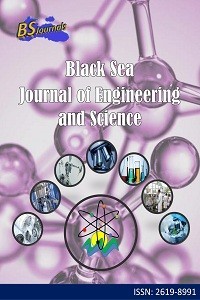Temperature-Dependent Debonding Resistance of 316 Stainless Steel, Inconel 625, and Ti-6AL-4V Alloys
Debonding resistance, Finite element, Additive manufacturing
Temperature-Dependent Debonding Resistance of 316 Stainless Steel, Inconel 625, and Ti-6AL-4V Alloys
Debonding resistance, Finite element, Additive manufacturing,
___
- Abd-Elaziem W, Elkatatny S, Abd-Elaziem AE, Khedr M, Abd El-baky MA, Hassan MA, Abu-Okail M, Mohammed M, Järvenpää A, Allam T, Hamada A. 2022. On the current research progress of metallic materials fabricated by laser powder bed fusion process: A review. J Mater Res Tech, 20: 681-707.
- Alfano G, Crisfield MA. 2001. Finite element interface models for the delamination analysis of laminated composites: Mechanical and computational issues. Int J Numer Methods Eng, 50(7): 1701-1736.
- Alzyod H, Ficzere P. 2021. Potential applications of additive manufacturing technologies in the vehicle industry. Design Machin Struct, 11(2): 5-13.
- Blackman BRK, Hadavinia H, Kinloch AJ, Williams JG. 2003. The use of a cohesive zone model to study the fracture of fibre composites and adhesively-bonded joints. Int J Fracture, 119(1): 25-46.
- Frascio M, Bergonzi L, Jilich M, Moroni F, Avalle M, Pirondi A, Monti M, Vettori M. 2019. Additive manufacturing process parameter influence on mechanical strength of adhesive joints, preliminary activities. Acta Polytech CTU Proc, 25: 41-47.
- Gu D, Shi X, Poprawe R, Bourell DL, Setchi R, Zhu J. 2021. Material-structure-performance integrated laser-metal additive manufacturing. Science, 372(6545): eabg1487.
- Kitamura K. 2021. Shape memory properties of Ti-Ni shape memory alloy / shape memory polymer composites using additive manufacturing. Mater Sci Forum, 1016: 697-701.
- Messmer NR, Anjos EGR, Guerrini LM, Oliveira MP. 2018. Effect of geometry and hybrid adhesive on strength of finger joints of Pinus elliottii subject to humidity and temperature. J Adhesion, 94(8): 597-614.
- Niu X, Singh S, Garg A, Singh H, Panda B, Peng X, Zhang Q. 2019. Review of materials used in laser-aided additive manufacturing processes to produce metallic products. Front Mechanical Eng, 14(3): 282-298.
- Omoniyi OA, Mansour R, Cardona MJ, Briuglia ML, O’Leary RL, Windmill JFC. 2021. Fabrication and characterization of a novel photoactive-based (0–3) piezocomposite material with potential as a functional material for additive manufacturing of piezoelectric sensors. J Mater Sci, 32(9): 11883-11892.
- Paul CP, Jinoop AN, Nayak SK, Paul AC. 2020. Laser additive manufacturing in industry 4.0: Overview, applications, and scenario in developing economies. Add Manufac App Metals Composites, 2020: 271–295. DOI: 10.4018/978-1-7998-4054-1.ch014.
- Yamazaki D, Iwanami M, Isa M. 2020. Assessment of outdoor exposure effects on the long-term durability of epoxy resin adhesives used for steel-plate bonding. J Adv Concrete Tech, 18(8): 463-472.
- Zou X, Huang L, Chen K, Jiang M, Zhang S, Wang M, Hua X, Shan A. 2021. Surface structuring via additive manufacturing to improve the performance of metal and polymer joints. Metals, 11(4): 567.
- Yayın Aralığı: 6
- Başlangıç: 2018
- Yayıncı: Uğur ŞEN
Gürkan KIR, Aslı ÜLKE KESKİN, Utku ZEYBEKOĞLU
Semra BAYHUN, Tuğçe ORAL, Mehmet ÖZDEMİR
Kil Eşdeğeri Bir Malzeme ve Uçucu Kül Katkısının Zemin Mukavemetine Etkisinin Araştırılması
Temperature-Dependent Debonding Resistance of 316 Stainless Steel, Inconel 625, and Ti-6AL-4V Alloys
Naringenin Baskılanmış Kriyojel Membranların Hazırlanması ve Adsorpsiyon Davranışlarının İncelenmesi
